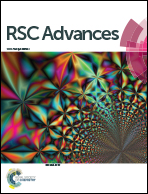Seedless, copper-induced synthesis of stable Ag/Cu bimetallic nanoparticles and their optical properties†
Abstract
In this study, we demonstrate a sensitive and selective method for the seedless synthesis of an Ag@Cu bimetallic nano-structured material based on the competitive coordination chemistry of cysteine with Cu2+ and Ag+. The subsequent addition of Ag+ to the cysteine–Cu2+, leads to the formation of a perfectly transparent orange–yellow color at 425 nm in the UV-visible region after ca. 3 h of mixing time. These changes are ascribed to the formation of Ag@Cu bimetallic nanoparticles. Visual observations and transmission electron microscope data indicate that the reaction mixture containing different orders of reactants (cysteine + Ag+, cysteine + Cu2+, Ag+ + Cu2+ + cysteine, and cysteine + Cu2+ + Ag+) have different colors as well as different morphologies. The reaction proceeds through the reduction of Ag+ ions into Ag0 by the side chain HS-moiety of the cysteine–Cu2+ complex. The resulting cystine–Cu2+ complex is subsequently adsorbed onto the surface of Ag0. The reduction of Cu2+ occurred on the surface of the Ag0 by under potential deposition. On the basis of this, the formation of Ag@Cu bimetallic nanoparticles can be visualized with the naked eye through the colorless-to-orange–yellow color change. Cysteine could not reduce the Cu2+ ions into metallic copper under normal conditions because Cu2+ has a strong affinity towards coordination through the thiol moiety.


 Please wait while we load your content...
Please wait while we load your content...